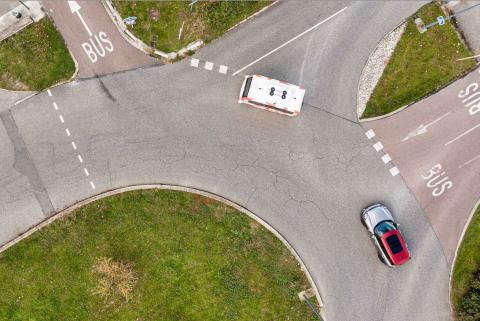We looked to Ansys software for a single-source, turnkey solution to demonstrate the safety of our driverless vehicles. They enabled engineers to work from a single model for all safety activities across platforms—significantly shortening development cycles, speeding time to market and reducing operational costs for our shuttle and tow tractor solutions.
Both operate at Level 4 of autonomous driving — meaning they have no human supervizor on board and are fully autonomous until a system failure is detected. EasyMile deployed Ansys software to conduct functional safety analysis of infrastructure and connected architecture for both vehicles.
High level of information to operate safely
Autonomous vehicle (AV) function depends on a high level of information to operate safely. The real-time data-processing supporting AV functionality is driven by input from a complex system of lidars, radars, cameras, internet of things (IoT) sensors, GPS and navigation software, all working together to give a 360-degree perspective of vehicle surroundings. To demonstrate safety at this level is difficult and requires clearly defined methods and tools for managing the complex architecture of these nonclassical systems.
Analyzing complex autonomous vehicle system architecture
Using Ansys software, EasyMile identified a single solution with all the tools needed to analyze their very complex AV system architecture. With Ansys’ help, EasyMile established clear guidelines for safety analysis, along with the unique templates and supporting documentation needed to successfully demonstrate the safety of their AV solutions for customers and various government regulatory bodies.
“It has been difficult in the past to demonstrate the safety of our products to clients,” says Romain Dupont, R&D for EasyMile. “Ansys medini analyze really helps us to streamline the process and bring it all together in a way that our clients can understand. Together with Ansys’ support, we’re helping shape future standards for autonomous vehicle safety.”
medini analyze is a software toolset supporting safety analysis for electronically-controlled safety related functions. It allows for the consistent and efficient application of industry guidelines specific to autonomous vehicle applications, helping to eliminate inconsistencies during analysis to accelerate certification.
“Autonomous vehicle technology is developing at a lightning-fast pace,” says Shane Emswiler, senior vice president of products at Ansys. “This challenges manufacturers and OEMs to reliably test and demonstrate the viability of these incredibly complex systems. We’re continuously evolving medini analyze to meet ever-changing safety criteria in support of successful customer deployments.”
Originally published as a news item on Ansys.com


